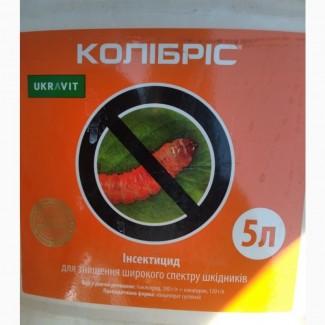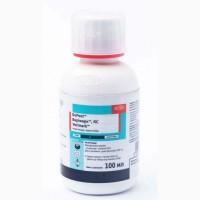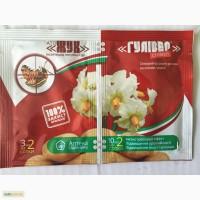/ Fertilizers and plant protection products / Insecticides / Kolibris - Innovative insecticide against pests...
Sell / buy
Kolibris - Innovative insecticide against pests in many crops, Kyiv region.
Price35$
Region:all Ukraine,
Kyiv region.
(Vyshhorodok)
Updated:
Kolibris - Innovative contact-systemic insecticide for the destruction of a wide range of pests in many crops.
Active substance: Thiacloprid 280 g/l, novaluron 120 g/l
Culture: Potatoes, cabbage, tomatoes, apple trees,grapes, cherries
Pests: Suckers and leaf-gnawers
Type: Contact-system
Drug form: Suspension concentrate
Packaging: 5 l canister, the price is for 1 l.
Advantages of the drug:
• an innovative combination of active substances ensures the destruction of pests at all stages of development and prevents the threat of resistance;
• controls a wide range of pests from the orders of Lepidoptera, Coleoptera, Homoptera and Diptera;
• blocks the process of larvae transition from one stage to another, which leads to their death;
• a long period of protective action and a quick "knockout effect" against the most dangerous pests;
• effective against pest populations that are resistant to pyrethroids and organophosphates;
• safe for entomophages and pollinators (can be used during the flowering period of crops).(//tractor-service.com)
Compatibility:
Compatible with other pesticides and agrochemicals that have a neutral reaction. Before preparing working mixtures, it is advisable to check the drugs for compatibility (absence of sediment, foam, delamination, lumping, incomplete dissolution of one of the drugs, etc.)
Mechanism of action:
Thiacloprid affects the nicotine-acetylcholine receptors of pests, which leads to a violation of the transmission of nerve impulses in them, while providing a quick "knockout" (convulsions and paralysis) effect, as a result of which the pests die. Novaluron disrupts the biochemical processes of the formation of chitin, a component of the cuticle of pests, this leads to the impossibility of larvae transitioning from one stage to another, which ultimately leads to the termination of their development cycle and, accordingly, death.
MAXIMUM MULTIPLICATION OF TREATMENTS PER SEASON — 2.
The waiting period from the last treatment to harvesting: apple tree - 30 days; rapeseed - 30 days;corn, soy,sunflower, potatoes, tomatoes, cabbage - 20 days; cherries, cherries, grapes - 30 days.
The rate of consumption of the working solution: fruit plantations - 500-1000 l/ha; field crops - 200-300 l/ha; grapes - 500-800 l/ha.
Features of application:
Spraying is carried out during the growing season of crops for the appearance of pests and exceeding their level of EPSH. It is necessary to ensure sufficient and uniform coverage of the processing culture without runoff of the working solution. One of the active substances reduces the fecundity of females, and upon contact with the drug laid eggs, regenerated larvae die. In the future, when the insecticide hits the larvae, the biochemical processes of chitin formation - a component of the cuticle of pests - are disrupted, this leads to the inability of the larvae to pass from one stage to another. The most optimal period for spraying against fruit eaters, moths, scoops and leafhoppers is the mass flight of butterflies and the beginning of the revival of larvae. Spraying must be carried out at an air temperature of +12 to 25°С and at a wind speed of no more than 5 m/s. Spraying should not be carried out immediately after frosts or in anticipation of them, and when plants are in a state of stress, as well as 4-6 hours before or after precipitation.
Active substance: Thiacloprid 280 g/l, novaluron 120 g/l
Culture: Potatoes, cabbage, tomatoes, apple trees,grapes, cherries
Pests: Suckers and leaf-gnawers
Type: Contact-system
Drug form: Suspension concentrate
Packaging: 5 l canister, the price is for 1 l.
Advantages of the drug:
• an innovative combination of active substances ensures the destruction of pests at all stages of development and prevents the threat of resistance;
• controls a wide range of pests from the orders of Lepidoptera, Coleoptera, Homoptera and Diptera;
• blocks the process of larvae transition from one stage to another, which leads to their death;
• a long period of protective action and a quick "knockout effect" against the most dangerous pests;
• effective against pest populations that are resistant to pyrethroids and organophosphates;
• safe for entomophages and pollinators (can be used during the flowering period of crops).(//tractor-service.com)
Compatibility:
Compatible with other pesticides and agrochemicals that have a neutral reaction. Before preparing working mixtures, it is advisable to check the drugs for compatibility (absence of sediment, foam, delamination, lumping, incomplete dissolution of one of the drugs, etc.)
Mechanism of action:
Thiacloprid affects the nicotine-acetylcholine receptors of pests, which leads to a violation of the transmission of nerve impulses in them, while providing a quick "knockout" (convulsions and paralysis) effect, as a result of which the pests die. Novaluron disrupts the biochemical processes of the formation of chitin, a component of the cuticle of pests, this leads to the impossibility of larvae transitioning from one stage to another, which ultimately leads to the termination of their development cycle and, accordingly, death.
MAXIMUM MULTIPLICATION OF TREATMENTS PER SEASON — 2.
The waiting period from the last treatment to harvesting: apple tree - 30 days; rapeseed - 30 days;corn, soy,sunflower, potatoes, tomatoes, cabbage - 20 days; cherries, cherries, grapes - 30 days.
The rate of consumption of the working solution: fruit plantations - 500-1000 l/ha; field crops - 200-300 l/ha; grapes - 500-800 l/ha.
Features of application:
Spraying is carried out during the growing season of crops for the appearance of pests and exceeding their level of EPSH. It is necessary to ensure sufficient and uniform coverage of the processing culture without runoff of the working solution. One of the active substances reduces the fecundity of females, and upon contact with the drug laid eggs, regenerated larvae die. In the future, when the insecticide hits the larvae, the biochemical processes of chitin formation - a component of the cuticle of pests - are disrupted, this leads to the inability of the larvae to pass from one stage to another. The most optimal period for spraying against fruit eaters, moths, scoops and leafhoppers is the mass flight of butterflies and the beginning of the revival of larvae. Spraying must be carried out at an air temperature of +12 to 25°С and at a wind speed of no more than 5 m/s. Spraying should not be carried out immediately after frosts or in anticipation of them, and when plants are in a state of stress, as well as 4-6 hours before or after precipitation.
|
Shop, contacts | |
Yuriy / feedback, info. / evaluation of activity | |
|
Phone:
+38(xxxxxx
show
| |
All ads user ~1000 | |
Ad ID: #1070367
(added by registered user, registration date: 2016-08-10)
Added / Updated: 10-14-2025 09:13 (current, until: 14-10-2026)
Permanent Ad Address:
Impressions / views for today: ?, total: ?
Similar ads
Among them there are many interesting ones...







